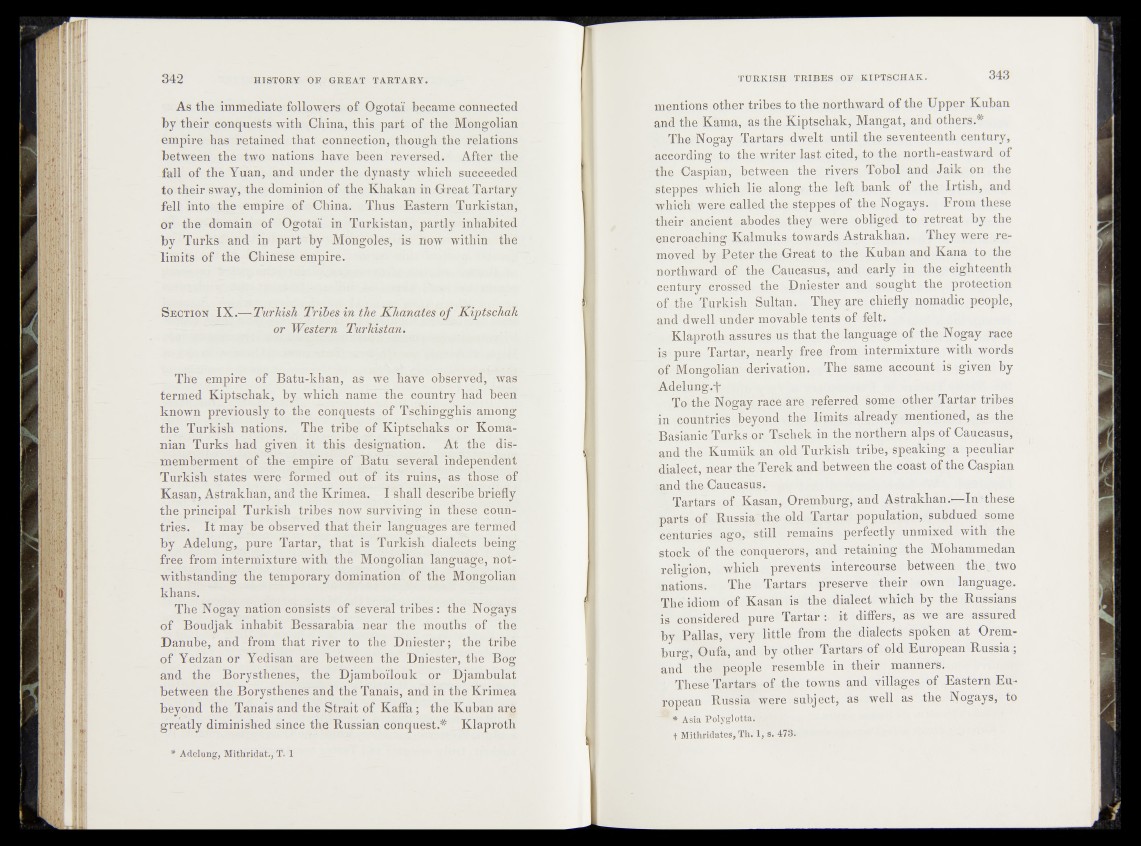
As the immediate followers o£ Ogota'i became connected
by their,conquests with China, this part of the Mongolian
empire has retained that connection, though the relation!
between the two nations hare been .reversed«' After the
fall of the Yuan, and under the dynasty .which succeeded
to their sway, the dominion of the Khakan in Great Tartary
fell into the empire of China. Thus Eastern Turkistan,
or the domain of Ogota'i in Turkistan, partly inhabited
bv Turks and in part by Mongoles, is now within the
limits of the Chinese empire.
S ection IX.—Turkish Tribes in the Khanates of Kiptschah
or Western Turkistan.
The empire of Batu-khan, as we haveobserved*, :was
termed Kiptschak, by which name the. country bad been
known previously to the conquests offTschin ggnis. am on g
the Turkish nations. The tribe of Kiptschaks or Koma-
nian Turks had given, it this designation. At the qisr
memberment of the empire of "Batu several independent
Turkish states were formed out of its ruins, as those of
Kasan, Astrakhan, and the Krimea. I shall describe briefly
the principal Turkish tribes now surviving in these’ countries.
It may be observed that their languages are termed
by Adelung, pure Tartar, that is Turkish dialects being
free from intermixture with the Mongolian language, notwithstanding
the temporary domination of the Mongolian
khans.
The Nogay nation consists of several tribes : the Nogays
of Boudjak inhabit Bessarabia near the mouths of the
Danube/and from that river to the Dniester ; the tribe
of Yedzan or Yedisan are between the Dniester, the Bog
and the Borysthenes, the Djamboilouk or Djambulat
between the Borysthenes and the Tanais, and in the Krimea
beyond the Tanais and the Strait of Kaffa; the Kuban arp
greatly diminished since the Russian conquest.* Klaproth
* Adelung, Mithridat., T. 1
mentions other tribes to the northward of the Upper Kuban
and the Kama,.^as the,Kiptschak, Mangat, and others.*
The Nogay Tartars dwelt^un« the seventeenth century,
^according fq the, wfit^r4a|||eiteil^4oithe north-eastward of
the Caspian, be.tv$ j^ »|fe rivers Tobol and Jaik on . the
whA^h/lie along the left bank of , tfjj||i Irtish, and
which* wergfpal|e(k|he- sfegp^of. the >N,fgaya. From these
their ancimfea h o t h q y , w^e obliged to retreat,,, by■ the
|encroaching K a,1 mM^s^tqv^ar^ A strakhan. Th^yv^fgrg removed
bv^B.fferkttefrCreat to ^M Kubaa&and Kana to the
&rfhward of the-Caueg^!, and>4e^||y in thepqighteenth
^century icroqsed, rth>e DphgMgq anght.^the^^Eofecticm
of^fhe>Yunkish^Jaltan. T h ^ a ra , chiefly nomadic ,people,
and dfaell under moVabfqfents
. Klaproth^assures^us that tl^lfhguag^qf the Nogay,race
is pi^e Tartar,Tnearly -%e^from Mptermixture with words
of Mong4ian derivation; The © same account isKgiyen. by
Adelung.%^
To the |$iqgay race are referred sqrhegotjher Tartar tribes
in countries jbeyphd^ip^ limits, already /mentioned, the
BasMui'CvTurks or Tsehek in the^prthern, a ] p 0 f Caucasus,
and th^lKumuk an old Turkish tj&jg,»speaking a peculiar
dialepit,\near the Terek and between the coast of the Caspian
;and theCaucasus.. ,
Tartars of Kasan, Orqmburg, and Astrakhan.—In’these
.parts of Russia'the old Tartar population,,subdu^-^me
centuries ago," still Remains perfectl^nmixcd with -the
stock of the conquerors* and -retainin^he Mohammedan
religion, which prevents intercourse bet^eeh^ibe,: two
nations. The Tartars preserve /thfe>own ^ language.
The idiom of Kasan is .the dialekf which by the Russians
iS considered pure Tartar differs, as we are assured
by Pallas, very little from the .dialects spoken at Orem-
burg, Oufa, and by other Tartars of old European Russia ;
and the people resemble in their manners,
These Tartars. • of the towns and villages of Eastern European
Russia were subject, as well as the Nogays, to
Asia PolyglOtia, ƒ'
t Mithridates, Th. 1, s. 478.